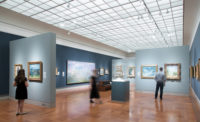Bloch Building, Nelson-Atkins Museum of Art
Steven Holl Architects merges architecture, art, and landscape into a unified experience for the Bloch Building at the Nelson-Atkins Museum of Art in Kansas City
Architects & Firms
Kansas City, Mo.
During construction, the reaction to Nelson-Atkins’ Bloch Building ran the gamut from irascible to irate. According to its intrepid museum director, Marc Wilson, the Kansas City public had liked Steven Holl Architects’ design well enough when viewing it as an architectural model. “But all models are tiny,” Wilson explains. It was another thing when the citizenry got a glimpse of the channel-glass-clad structures, coming out of the muddy turf atop the 840-foot-long linear underground galleries. Winding down the eastern slope, hard by the classically styled Nelson-Atkins museum, all five polyhedral forms looked like so many icebergs threatening to sink the Titanically proportioned limestone building designed in 1933 by Wight and Wight.

Observers dismissed Holl’s “lenses,” as he calls the irregularly geometric light monitors, as shipping containers. Such ire, reportedly unnerved even the new building’s lead donor, Henry Bloch (founder of H&R Block) for whom the 165,599-square-foot building is named.
Now Holl and Wilson can feel fully vindicated. The building opened in early June with great fanfare and overwhelmingly adulatory press. Steven Holl, AIA, his partner Chris McVoy, and the local architects Berkebile, Nelson, Immenschuh, McDowell (BNIM) under the leadership of Casey Cassias, AIA, can now rightfully enjoy the credit due after eight years of grueling effort.
True, museums usually enjoy an intense if too brief honeymoon when they first open. This is before leaks occur, or before visitors and curators start to complain that the architectural extravaganza overwhelms the art. For now, not even a storm has blown in to test the claim that the glass can withstand winds up to 135 miles an hour. On top of that, the permanent collection of contemporary art fits into the spaces smoothly and strikingly. And while neighborhood residents thought the shipping containers didn’t quite fit in with the Ionic-columned, symmetrical temple of art, the lenses, luminous with interior lighting at night; glinting in the sun by day, are looking a lot better amid the 50,000 square feet of grass-planted roofs connecting them. Indeed the integration of art, landscape and architecture creates a dynamic whole where visitors—including this observer––are bowled over by the experience of meandering through and around the exterior and interior spaces.
Within the entire addition, Holl devised a promenade architecturale in the Corbusian sense, that, is a processional path that begins in the first lens as you are drawn by the downward tilt of the ramp through the museum’s atrium.
PeopleArchitect Design Architects: Partner-in-Charge: Project Architects: Project Team: Local Architect(s): Principal in charge / project manager: Senior project architect: Project architects: Project team: Structural engineer(s): Associate structural engineer(s): Mechanical engineer(s): Glass consultant(s): Lighting consultant(s): Landscape architect(s): Artist(s):
|
Products |







